
Спидометр. Виды и устройство. Погрешность и особенности
Содержание
- Что такое автомобильный спидометр?
- Для чего нужен спидометр?
- История создания
- Виды
- Как устроен механический прибор, принцип работы
- Работа электромеханического спидометра
- Работа электронного прибора
- Почему он врёт: существующая погрешность
- Основные неисправности спидометров
- Диагностика и устранение неисправностей механического прибора
- Ремонт и диагностика электронного спидометра
- Особенности эксплуатации
- Отличия: спидометр и одометр
- Вопросы и ответы:
Практически с первым серийным выходом автомобилей, их стали оснащать необходимыми приборами, среди которых есть спидометр. Автомобильные приборы помогают контролировать необходимые процессы, техническое состояние, уровень и температуру жидкостей.
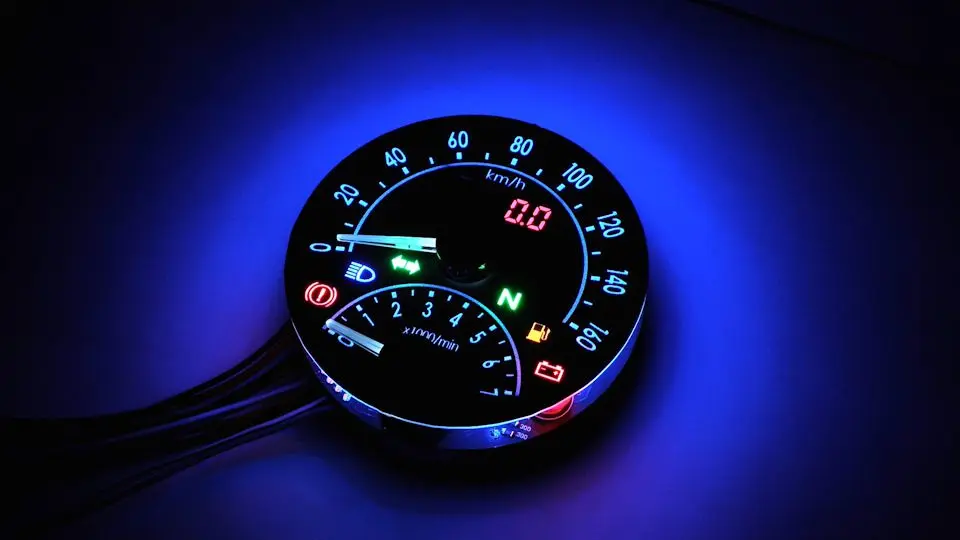
Что такое автомобильный спидометр?
Спидометр представляет собой измерительный прибор, показывающий реальную скорость транспортного средства. Для автомобилей применяют механический и электронный спидометр, а скорость указывают в милях или километрах в час. Расположен спидометр на приборной панели, как правило, перед водителем, интегрирован с одометром. Также есть варианты, при которых панель приборов смещена в центр торпеды и обращена в сторону водителя.
Для чего нужен спидометр?
Данный девайс помогает в режиме реального времени, водителю узнать о:
- интенсивности движения транспортного средства;
- скорости движения;
- расходе топлива на конкретной скорости.
Кстати, часто на спидометрах отметка максимальной скорости немного выше, указанной в характеристиках автомобиля.
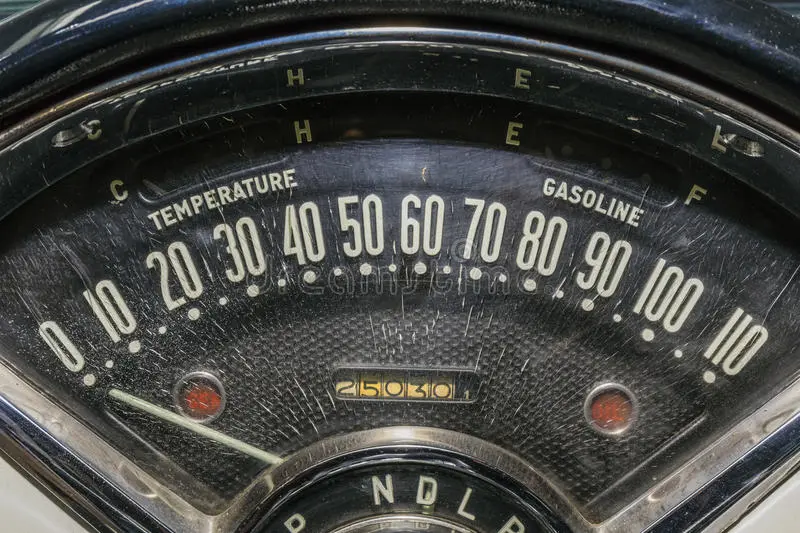
История создания
Самый первый спидометр, устанавливаемый на легковой автомобиль, появился в 1901 году, а тем самым авто был Oldsmobile. Однако в интернете бытует такое мнение, что первый аналог спидометра был придуман русским умельцем Егором Кузнецовым. Впервые, обязательной опцией, спидометр стал в 1910 году. OS Autometer стал первым производителем, выпускающим спидометры для транспортных средств.
В 1916 году, Никола Тесла придумал спидометр с принципиально своей конструкцией, основа которого, используется по сей день.
С 1908 по 1915 год выпускались барабанные и стрелочные спидометры. Позже стали применять цифровые и стрелочные. Кстати, все автопроизводители остановили свой выбор на стрелочных, в силу удобства чтения показаний.
С 50-х по 80-е годы прошлого века использовали ленточные спидометры, чаще всего на американские автомобили, как и барабанные. От этих видов спидометра отказались в силу низкой информативности, которая может привести к опасным ситуациями на дороге.
В 80-х годах японцы постепенно внедряют цифровые спидометры, однако массового применения это не получило в силу некоторых неудобств. Оказалось, что аналоговые показатели лучше читаются. Цифровые спидометры нашли свое применение на спортивных мотоциклах, где это оказалось реально удобно.
Виды
Несмотря на то, что вариаций спидометров масса, классифицируются они по двум видам:
- какой метод измерения используется;
- какой тип индикатора.
Разновидность делится на 3 категории:
- механический;
- электромеханический;
- электронный.
Для понимания скорости переменного движения авто, который показывает спидометр, и как обеспечивается измерение — рассмотрим подробно специфику работы и обработки данных.
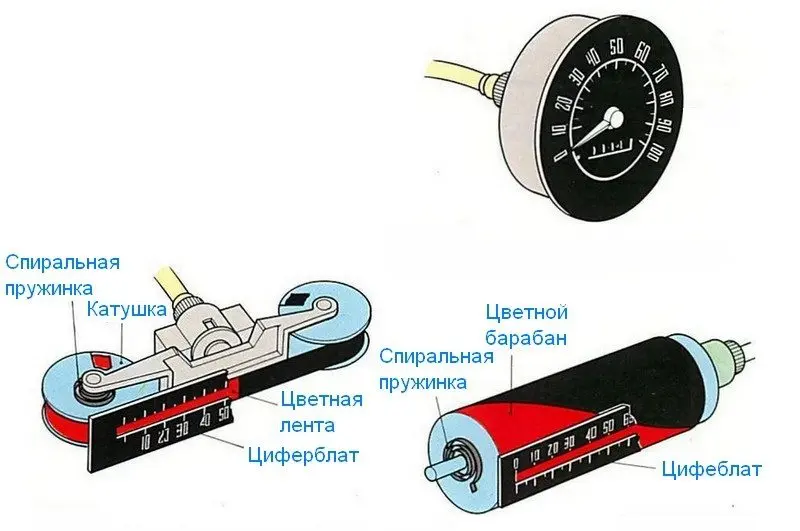
Способ измерения
В этой категории, автомобильные спидометры делятся на следующие классификации:
- хронометрический. Функционирование основывается на показаниях одометра и часов — расстояние делится на потраченное время. Способ опирается на законы физики;
- центробежный. Способ основан на работе центробежной силы, где фиксируемая пружиной манжета плеча регулятора и ходит в стороны за счет центробежной силы. Расстояние смещения равен интенсивности движения;
- вибрационный. За счет резонанса колебаний подшипника или рамы создается вибрационная градуированная, равная числу вращения колеса;
- индукционный. За основу взята работа магнитного поля. Применяют постоянные магниты на шпинделе, где при вращении колеса создается вихревой ток. В движении участвует диск с пружиной, отвечающий за правильные показания стрелки спидометра;
- электромагнитный. Датчик скорости, при движении посылает сигналы, количество которых равно числу движения привода датчика;
- электронный. Здесь механическая часть обеспечивается импульсами тока, которые передаются при вращении шпинделя. Информацию получает счетчик, который определяет частоту за фиксированный промежуток времени. Данные конвертируются в километры в час и выводятся на панель приборов.
Интересный факт! Массово внедрять механические спидометры стали в 1923 году, с тех пор их конструкция мало чем изменилась до нашего времени. Первые электронные счетчики скорости появились в 70-х годах, однако массовость приобрели спустя 20 лет.
По типу индикации
По индикации спидометр делится на аналоговый и цифровой. Первый работает за счет передачи момента за счет вращения редуктора, который связан с коробкой передач или редуктором моста.
Электронный спидометр выигрывает точностью показателей, также электронный одометр всегда указывает точный пробег, суточный пробег, а также предупреждает об обязательном ТО на определенном пробеге.

Как устроен механический прибор, принцип работы
Механический счетчик скорости состоит из следующих основных компонентов:
- датчик скорости транспортного средства шестеренчатый;
- гибкий вал, передающий информацию на щиток приборов;
- сам спидометр;
- счетчик пройденного пути (узел).
Магнитоиндукционный узел, взятый за основу механического спидометра, включает постоянный магнит, соединенный с приводным валом, а также цилиндрическую алюминиевую катушку. Центр поддерживается подшипником. Для предотвращения ошибок в показаниях, верх катушки накрыт алюминиевым экраном, защищающий от воздействия магнитного поля.
На коробке переключения передач есть пластиковая шестерня, или набор шестерен, которая сообщается с одной из шестерен КПП, и через трос передает первичную информацию.
Работает спидометр так: при вращении катушки создаются вихревые токи, из-за чего она начинает отклоняться на определенный угол, который в свою очередь, зависит от скорости движения авто.
Привод спидометра осуществляется за счет передачи крутящего момента через датчик и гибкий вал на блок шестерен. Минимальная погрешность показаний обеспечивается непосредственной связью с вращением ведущих колес.
Работа электромеханического спидометра
Данный вид счетчиков скорости более популярен, особенно на автомобилях отечественного производства. Суть работы пересекается с механическим, однако отличается реализацией процесса.
В электромеханическом спидометре применяют такие датчики, как:
- шестеренчатый с вторичным валом КПД и левым приводом колеса;
- импульсный (датчик Холла);
- комбинированный;
- индукционный.
Модифицированный скоростной узел использует индикацию магнитоэлектрических приборов. Для точности показателей применяли миллиамперметр. Обеспечивается работа такой системы микросхемой, передающей сигналы на электронный блок, передавая показания на стрелку спидометра. Сила тока прямо пропорциональная скорости движения авто, поэтому здесь спидометр показывает максимально достоверную информацию.
Работа электронного прибора
Отличается электронный спидометр от вышеописанных, тем что он связан непосредственно с одометром. Сейчас все автомобили оснащаются данной системой, редко позволяющей простыми способами скорректировать пробег, который “запоминается” некоторыми блоками управления.
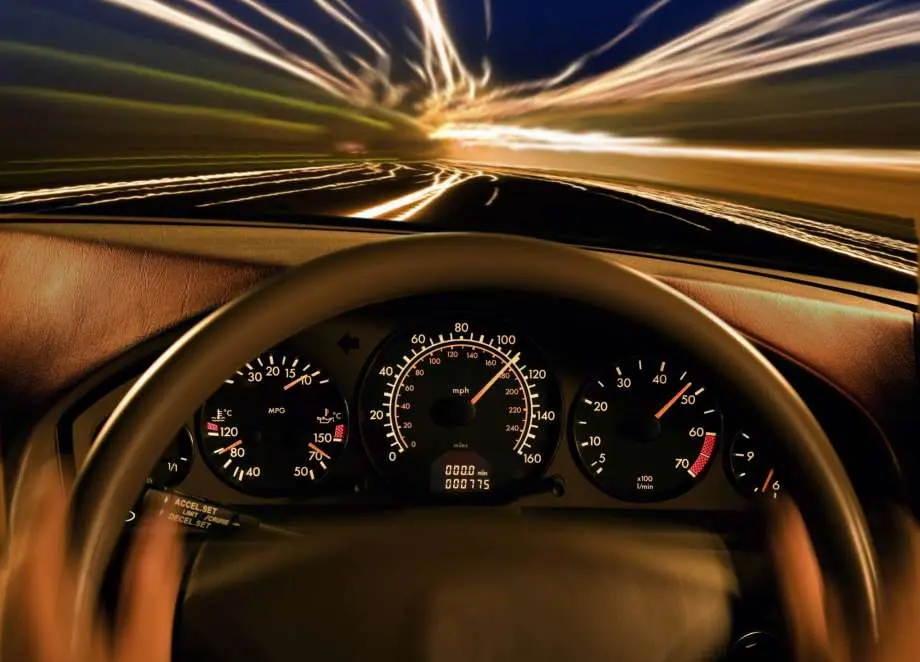
Почему он врёт: существующая погрешность
Доказано, что у большинства автомобилей, с высокой вероятностью, спидометр показывает не точную скорость. Допускается разница в 10% при скорости 200 км/ч, при 100 км/ч превышение будет около 7%, а при 60 км/ч погрешности нет.
Что касается внешний причин погрешности, то их несколько:
- установка колес и шин большего диаметра;
- замена редуктора моста с другой главной парой;
- замена коробки передач с другими парами шестерен.
Основные неисправности спидометров
Существует 5 основных видов неисправностей, возникающих в процессе длительной эксплуатации авто:
- естественный износ пластиковых шестеренок;
- обрыв троса в месте соединения с вращающейся частью;
- окисленные контакты;
- поврежденная проводка питания;
- неисправна электроника (необходима комплексная диагностика, включая датчик скорости).
В большинстве случаев поломок не нужно быть экспертом, главное правильно произвести диагностику неисправности и вооружится минимальным набором инструментов с мультиметром.
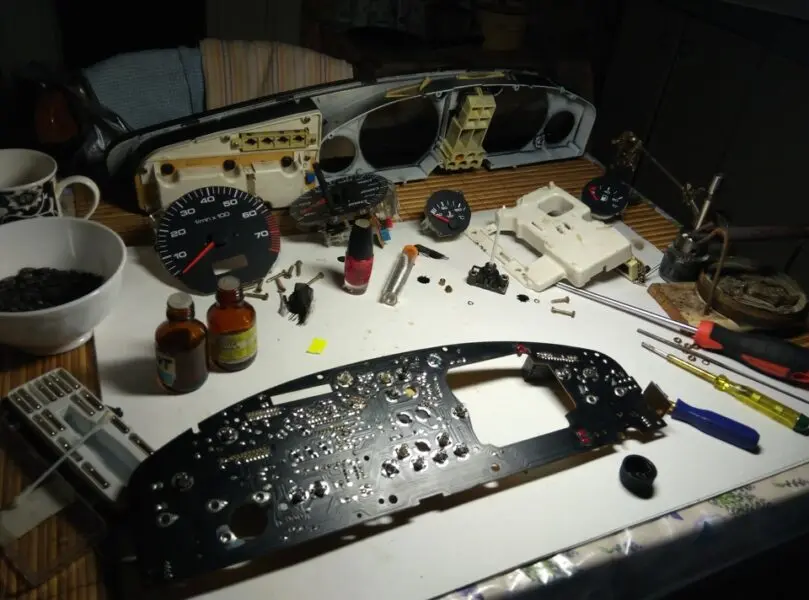
Диагностика и устранение неисправностей механического прибора
Для правильной диагностики пользуйтесь следующим алгоритмом действий:
- Приподнимаем пассажирскую сторону автомобиля, используя домкрат.
- Пользуясь инструкцией по ремонту и эксплуатации вашего авто, правильно производим демонтаж щитка приборов.
- Удалить фиксирующую гайку троса спидометра, снять щиток, запустить мотор и включить 4 передачу.
- В защитном кожухе трос должен проворачиваться. Если так и получилось — закручивайте наконечник троса, повторно включите 4 передачу на запущенном моторе и оцените показания на индикаторе. О неисправности скажет меняющая положение стрелка.
Если трос не вращается, то его необходимо демонтировать со стороны КПП и убедится, что форма его наконечника квадратная. Попробуйте самостоятельно тить трос- с обоих концов вращения должно быть одинаковым, и если это так — проблема в шестерне.
Ремонт и диагностика электронного спидометра
Здесь ремонт усложняется тем, что в наличии необходимо иметь, как минимум индикатор, как максимум — осциллограф или сканер для считывания показаний работы двигателей с электронным впрыском топлива. Абсолютно все автомобили иностранного производства, после 2000 года, имеют бортовой компьютер, производящий самодиагностику перед запуском авто. Если есть ошибка — ее код можно расшифровать, обратившись в таблице кодов ошибок конкретной марки авто.
Если есть ошибка, связанная с отсутствием работы спидометра, то при помощи осциллографа подключаемся к среднему контакту датчика скорости, а “+” кидаем на АКБ. Далее запускается мотор и включается передача. Частота рабочего датчика варьируется от 4 до 6 Гц, а напряжение не менее 9 вольт.
Особенности эксплуатации
Главным недостатком, которые лишены другие приборы, является погрешность. Как указано выше, правильность показания скорости зависит от внешнего вмешательства в видео установки больших колес и трансмиссионных агрегатов с другими передаточными числами. При критическом износе шестерни показания спидометра “гуляют” еще на 10%.
Электронные датчики могут показывать скорость и пробег без погрешности при условии соблюдения правил эксплуатации и без превышения допустимых размеров колес.
Если спидометр вышел из строя — эксплуатировать автомобиль, при такой неисправности, запрещается согласно правилам дорожного движения.
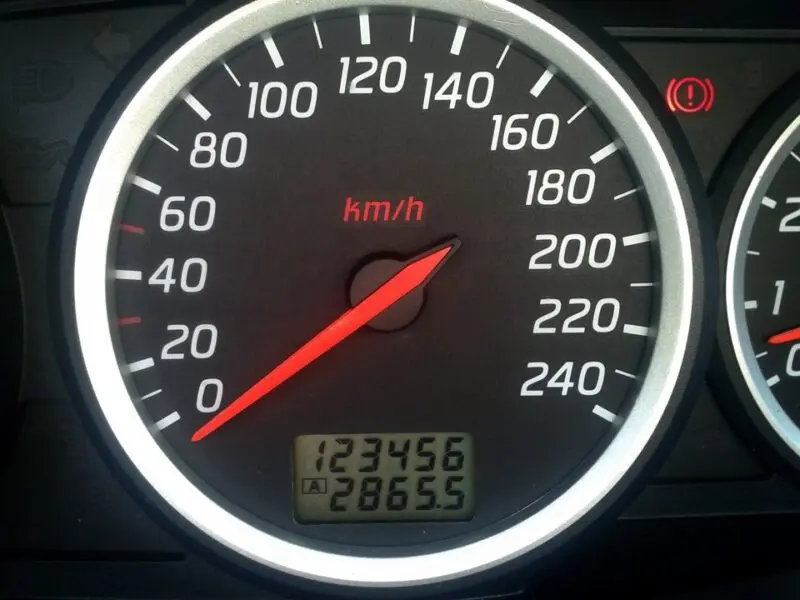
Отличия: спидометр и одометр
Одометром называется датчик, который читает суммарный и суточный пробег автомобиля. Одометр показывает пробег, спидометр — скорость движения. Раньше одометры были механически, и пробег активно скручивался недобросовестными продавцами автомобилей. Электронные счетчики пробега также научились редактировать, однако в автомобиле существует множество блоков управления, которые фиксируют пробег. Да и блок управления двигателем, в своей памяти, фиксирует все ошибки, возникающие на определенном пробеге.
Вопросы и ответы:
Как называется спидометр в автомобиле? Некоторые автомобилисты одометр называют спидометром. На самом деле спидометр измеряет скорость авто, а одометр – пройденное расстояние.
Что означает второй спидометр в машине? Корректно называть его одометр. Он измеряет общий пробег автомобиля. вторая цифра одометра – суточный счетчик пробега. Первый не сбрасывается, а второй можно сбросить.
Как узнать точную скорость автомобиля? Для этого в машине стоит спидометр. Во многих авто на передаче 1 машина разгоняется до 23-35 км/ч, 2-й – 35-50 км/ч, 3-й – 50-60 км/ч, 4-й – 60-80 км/ч, 5-й – 80-120 км/ч. но это зависит от размера колес и передаточного числа КПП.
Как называется скорость измеряемая спидометром? Спидометр измеряет, с какой скоростью в конкретный момент движется автомобиль. В американских моделях показатель выдает мили в час, в остальных – километры в час.
